Key Document Hearings: Security Centers and Internal Purges
Today, August 12, 2016, the first day of the key document hearings in relation to Security Centers and Internal Purges were heard. The Co-Prosecution and Civil Party Lead Co-Lawyers presented a range of documents that aimed at highlighting the most important documents in relation to treatment of prisoners, authority structures, and the knowledge and responsibility of Nuon Chea and Khieu Samphan in particular with regards to S-21.
Co-Prosecution: Key Documents
All parties were present, with Nuon Chea following the hearing from the holding cell. Judge Nil Nonn was still absent.
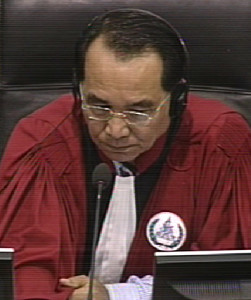
Judge Ya Sokhan
The presiding judge Ya Sokhan pointed to a memorandum of January of this year, which had laid out that the Chamber had a preference for documents directly relevant to trial segment; that Written Records of Interviews were allowed; and that documents relating to national policy were also allowed (but that they might be more appropriate for segment on the role of the accused); that torture tainted evidence was not permissible.[1]
The floor was then granted to the Co-Prosecution to present what they considered the key documents in relation to internal purges and security centers.
Mr. Srea Rattanak took the floor and began by presenting key documents in relation to Au Kanseng Security Center.
Au Kanseng
First, he pointed to documents that the Co-Prosecution said showed the arrest and execution of approximately 200 Jarai prisoners by Division 801 per instruction from Phnom Penh. He highlighted telegrams as well as testimonies of people who had been at Au Kanseng Security Center, in particular to the previous testimony of now-deceased former Khmer Rouge cadre Chhaom Se, who had acknowledged that a large group of Jarai died.[2]
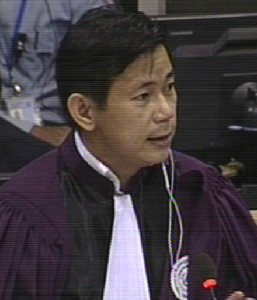
National Deputy Co-Prosecutor Srea Rattanak
Second, Mr. Rattanak referred to the capture of people who were implicated in confessions and sent to S-21 and referred to a report by Sao Saroeun, alias Roeun, in which it was indicated that “anyone who is suspicious must absolutely be arrested”.[3] He also stressed the importance of Chhaom Se’s testimony again, as well as the OCIJ Prisoner List, handwritten annotations on telegrams, and other Written Records of Interviews. These documents related to the arrest of people “who had been implicated in responses” and to the arrest of “ordinary people” such as wives and children.[4] Moreover, he pointed to documents that related to the treatment of prisoners and their deaths.[5] After his approximately half an hour presentation, he gave the floor to his international colleague Andrew Boyle.
Phnom Kraol
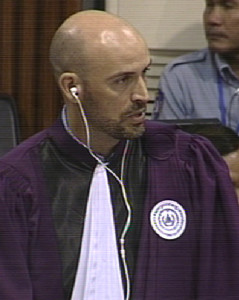
International Assistant Prosecutor Andrew Boyle
Assistant Prosecutor Andrew Boyle listed those documents that were related to Phnom Kraol Security Center, Sector 105, and Division 920. He began by discussing documents that seemed to indicate the authority structure of the offices and then continued by talking about the arrests of high ranking cadres, as well as about an increase in the number of arrests and killings, and the implementation of stricter rules after the appointment of Saroeun as chief of the security center.[6] Moreover, he directed the Chamber’s attention to documents about the detention conditions at Phnom Kraol,[7] interrogations,[8] and executions, living conditions, and work conditions.[9] He highlighted a document that referred to the arrest of former soldiers and policemen, as well as their family members.[10] Next, Mr. Boyle read out a document that indicated conditions at the security center and in which a person had referred to the execution of a member of an ethnic minority.[11] As a last part of the documents in relation to Phnom Kraol Security Center, he pointed to those that related to the “situation at the border”,[12] the “Group of 7”,[13] and the arrest of people, in particular during the purge of Division 920.[14]
He then turned to the relationship and conflict with Vietnam in Mondulkiri in general.
Relationship and Conflict with Vietnam
Mr. Boyle stressed documents that showed that there had been regular contact between division and sector cadres and the Vietnamese side and that Democratic Kampuchea forces were attacking while others were attempting to negotiate with the Vietnamese.[15] Lastly, he directed the Chamber’s attention to Ta Ya’s role in negotiations with Vietnam and said that he had been criticized as being “too soft”. His last document seemed to indicate that the arrest of Ya was not related to rebellion he might have led. In this document, it was indicated that it was “unlikely that they were plotting against Pol Pot”.[16]
S-21
After the break, International Co-Prosecutor Nicholas Koumjian took the floor and elaborated on the documents falling into the realm of S-21.
His first round of documents related to the number of people being imprisoned and killed at S-21 and Choeung Ek (8985 bodies having 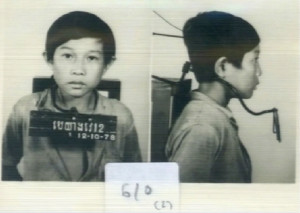 been exhumed at Choeung Ek in 129 pits according to the Choeung Ek Forensic Evaluation Study, including around 6,200 skulls and 63,113 other skeletal elements; another document pointed to approximately 7,700 bodies having been found, 15,101 by OCIJ).[17] Mr. Koumjian also showed a document that seemed to indicate that confessions had been lost.[18] Mr. Koumjian also covered the execution of children at S-21, [19] the increase of number of prisoners at S-21,[20] purges and arrests as well as killings.[21]
been exhumed at Choeung Ek in 129 pits according to the Choeung Ek Forensic Evaluation Study, including around 6,200 skulls and 63,113 other skeletal elements; another document pointed to approximately 7,700 bodies having been found, 15,101 by OCIJ).[17] Mr. Koumjian also showed a document that seemed to indicate that confessions had been lost.[18] Mr. Koumjian also covered the execution of children at S-21, [19] the increase of number of prisoners at S-21,[20] purges and arrests as well as killings.[21]
Next, Mr. Koumjian listed documents that meant to show that S-21 was a prison in which torture was systematically used, created by the central government, and whose establishment was not attributable to Vietnamese infiltrators.”[22] Another document was the book The Eyes of the Pineapple that showed an increasing number of arrests.[23] Furthermore, he used an interview with Van Nath, who had talked about the living conditions at S-21.[24] Mr. Koumjian then pointed to a few documents to show that high ranking cadres did not believe in confessions,[25] that even high ranking cadres were subject to a suspicious environment and that accusations spread,[26] that Pol Pot did not believe in confessions himself.[27]
Role of Khieu Samphan
Mr. Koumjian pointed out that Khieu Samphan claimed to have been ignorant of S-21, the number of prisoners there, as well as the arrest and killings of specific prisoners. Mr. Koumjian pointed to what he considered inconsistencies between statements that Khieu Samphan had made and interviews that he had given.[28]
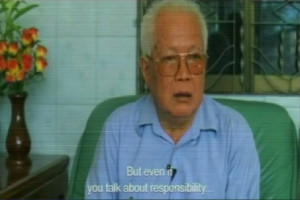
Khieu Samphan
Mr. Koumjian then directed the Chamber’s attention to documents that indicated that also children were detained at S-21. For example, the OCIJ Prisoner List included 67 prisoners who were 14 or younger, and not all ages had been recorded. Mr. Koumjian gave the example of the daughter of Brother Number 10 (who is believed to have been Vorn Vet) and who was six years old when entering S-21.[29] Khieu Samphan answered, when the interviewer said that the youngest child at S-21 was ten years old, that Cambodia would have been “in the hands of the Vietnamese” without Pol Pot and the Khmer Rouge.[30] Furthermore, Nuon Chea had said that he and Pol Pot “always ate their meal together”, and that Khieu Samphan often ate with them.[31]
At this point, the President adjourned the hearing for a break
Role of Nuon Chea
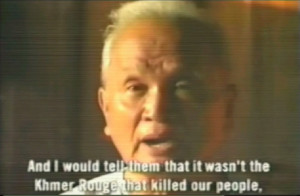
Nuon Chea
As for the role of co-accused Nuon Chea, Mr. Koumjian first set out a few documents to show the conflicting relation that Nuon Chea had with Vietnam: on the one hand, he said they were responsible for killings, and on the other he had said that the ones who were killed were under the influence of the Vietnamese. Additionally, Le Duan, the leader of the Vietnamese communists had said on November 16 1976 that “[Nuon Chea] is our man indeed”.[32] Nuon Chea had also said that criminals had to be killed and destroyed. Nuon Chea had said that he was not “scared or sad when they were killed.” when his former comrades and colleagues were executed”.[33] Nuon Chea also was reported to have said that they had to solve the “traitor problem the way we did”[34] Mr. Koumjian stressed that documents and interviews indicated that Nuon Chea was well aware of confessions of S-21.[35]. Mr. Koumjian then pointed to documents that indicated that Nuon Chea became the de facto superior when Son Sen went to the battlefield.[36] Mr. Koumjian then pointed to a talk by Nuon Chea to a Danish delegation, in which he had said that “there can be no comparison between losing two to three leading cadres and two hundred to three hundred members. Rather the latter than the former”.[37] Mr. Koumjian then concluded his presentation by showing a clip to the Chamber in which Nuon Chea said that “An individual’s needs can be met later. But if the individual becomes a problem, then they must be solved” and answered the question of whether he was sorry for those who were killed with “I have no regrets”. With this, Mr. Koumjian concluded the key document presentation for the Co-Prosecution and the floor was handed to the Civil Party Lawyers.
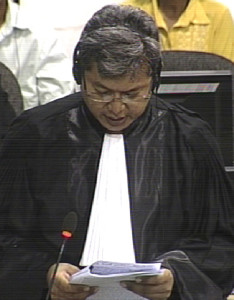
National Lead Co-Lawyer Pich Ang
Civil Party Key Documents
National Civil Party Lead Co-Lawyer Pich Ang highlighted several Civil Party Applications, who had lost their relatives, namely Sev Liem, Om Mon, Kong Teis, , Khaut Yat, Nuon Neang, Cheng Chhun Eang and Mao Eng Chhun. They had lost their close family members, including their husbands and siblings.[38] They described the arrests and disappearance of their family members and some described the mistreatment of prisoners, including torture and beating of children. These related to Au Kanseng and Phnom Kraol. At this point, the President adjourned the hearing for a break.
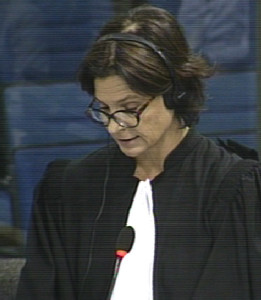
International Civil Party Lead Co-Lawyer Marie Guiraud
At the beginning of the last session, Judge Ya Sokhan announced a ruling by the Chamber in relation to a request by the Lead-Co Lawyers to admit two documents into evidence.[39] The first document was admitted, since it constituted the prior Civil Party Statement of one Civil Party who is called to testify. The second one was rejected, since 2-TCCP-1048 had been withdrawn from the list. Mr. Pich Ang then continued his presentation and referred to three civil parties who had lost their brothers and son, namely Ros Men, Lat Leng, and Va Sun.[40] International Civil Party Lead Co-Lawyer Marie Guiraud continued her part on the key documents presentation.
Ms. Guiraud started by presenting a series of S-21 lists and referred to six Civil Parties in total. She argued that the OCIJ list E3/10604 had been a very important tool for the Civil Parties, since this gave the Civil Parties the opportunity to know the date of entry and execution of their relatives, an information that they had not known before.
She then told the Court about the fate of six Civil Parties, who had lost their husbands and brothers. These Civil Parties were Seang Thann, Keo Kim Horn, Seang Vanndi, Chum Neou, Martine Lefeuvre and Hou Yat.[41]
With this, the key document hearing came to an end. Responses will be heard on Wednesday, August 17, 2016. Monday, August 15, 2016, the Victim Impact Statements that had begun yesterday will be continued.
[1] E315/2.
[2] E3/240, Telegram 15 June 1979 from Secretary of the Northeast Zone; E1/177.1, at 10:36; Written Record of Interview E3/407, at Answer 21; E3/405, at answer 12; E3/240, Telegram of 15 June
[3] E3/1164, Section 4, at 0052327 (KH), 00516711 (EN), 00532754 (FR).
[4] E3/405, at answer 6; E3/407, at answer 6; E3/3655, at 00173999 (KH), 00224628 (EN), 00271447 (FR); At 00783155 (EN), 00807271- 72 (FR); At 00783155 (EN), 00807271-72 (FR). E3/393.2; number 4535; E3/9646; E3/405, at answers 9, 12, 13, 14, and 16;
[5] E3/3984, at answer 3.
[6] E3/1664, Khmer Rouge Purges in the Mondulkiri Highlands, at 00397614-15 (EN); 00397640 ; 00397653-54.
[7] E3/733, at 00242171 (EN), 00236746 (KH), 00426116 (FR);
[8] 00242171-72 (EN), 00236746-47 (KH), 00426116-17 (FR).
[9] at 00242172 (EN), 00236747 (KH), 00426117 (FR).
[10] E3/7702, at 00239509 (EN), 00236727 (KH), 00274825 (FR); 00239510 (EN), 00236727 (KH) 00274825-26 (FR).
[11] At 00239510 (EN), 00236728 (KH), 00274826 (FR).
[12] E3/1194, Telegram
[13] E3/1196, Telegram, to Office 870, 26 November 1976, copied to brother Nuon and Brother Khieu; E3/170, at 00143134 (EN), E3/160a; Telegram of 4 December 1976.
[14] E3/1199; E3/93.2; E3/877; Telegram to Office 870, 20 May 1977; E3/1204, Telegram to Office 870.
[15] E#/9288, Report from Division 920 to Brother 89, 10 January 1976, at paragraph 2; E3/1020, 22 October 1976; E3/866; E3/8373 Report from Chhin to Son Sen, 29 February 1976; E3/932, Report to Son Sen, at paragraph 1; E3/217; E3/9270, Minutes of Standing Committee Meeting, at Section 1.
[16] E3/1664, at 00397623-24 (EN); at 00397629 (EN).
[17] E404/2.1.3, 01240560, 01240557 (KH); E3/404, at 01235435 (KH), page 2 in English. E393.2; 15,101; OCIJ List
[18] E3/2817, The Lost Executioner, at 00370428 (KH), page 178 (EN).
[19] E393.2, 12904, 10120; E3/94.1; E3/8639.171 at 00000223; E3/8463, at 00016000-04, Number 69; E3/8463, at 0016039-74 (KH).
[20] At 011150874 (KH), 01242753 (FR), David Chandler; E3/20, Elizabeth Becker, at 00638525 (FR), 00232351 (KH), page 266 (EN).
[21] E3/9, 00639957-60 (KH), 00396591-94 (EN).
[22] E3/1757, Vickery, page 161 (EN), no translation.
[23] E3/7333, Eyes of the Pineapple, at 0102270 (EN), no translation.
[24] E3/536R, at 10:50.
[25] Behind the Killing Fields, at 00849448 (FR), 00757537 (EN).
[26] E3/4202, at 00858359 (KH), 00849449 (FR), 00757537 (EN).; and 00849413 (FR), 00757520 (EN)
[27] At 00858362 (EN), 00849450 (FR). E3/1870, Telegram; E3/181, Telegram, 14 April 1978, at point 5.
[28] E3/109/2.3R; E393.2; E3/ XX at 00711393 (KH), 00722080 (FR), 0002760-61 (EN); E3/4035, at 00780955-56 (KH), 00790532-33 (FR), 00789051-52 (EN); E3/4023, at 00784642 (KH), 00818737 (FR), 00789370 (EN); E3/203, at 00385409 (KH), 000434232 (FR), 00424013 (EN); E3/3169, at 00711413-14 (KH), 00156637-38 (FR), 00002771 (EN);
[29] Entry number 14923.
[30] E3/210, Interview with OCIJ, 00156690 (KH), 00156695 (FR), 00156948 (EN); E3/18, at 00595513 (FR), 00103891 (KH), 00103794 (EN).
[31] E3/1550, 18 May 1977, at 00008923 (KH), 00766902 (FR), 00759651 (NE).
[32] Pol Pot’s Shadow: E3/81, at 00849344 (FR); E3/9644, at 0112015 001085974-75 (EN), 01125304 (FR).
[33] At 00849435-36 (FR).
[34] E393.1; Behind the Killing Fields, At 00858309 (KH), 00849415 (FR), p 84.
[35] E3/536R.
[36] E3/4202, Behind the Killing Fields at pp. 111, 115, p. 85, 00858310 (KH), 00849416 (FR). E3/8463, 14 February 1978, at 00016147-50 (KH); 6153 (KH); 6224 (KH); 6161 (KH); 6248 (KH); 6165 (KH); 6105 (KH); 6123 (KH); 6184 (KH); 6199 (KH); 6039-74 (KH), at 01032508 (EN).
[37] E3/196, at 00224475 (KH), 00762401 (EN).
[38] E3/6004, at 004946476-78 (KH), 01066675-76 (EN); 01142540 (FR); E3/4927, at 00545992-93 (KH), 01060162 (EN), 0090149-50 (FR); E3/7700, at 00236695-97 (KH), 00239532-33 (EN); 00267707-08 (FR); E3/5887, at 00211452 (KH), 00234051 (EN), 00285241 (FR); E3/6353, at 00535452 (KH), 01298058 (FR) no English translation available; E3/6353, at 00535657 (KH), 01298060-61 (FR); E3/9842, List of Prisoners Who Entered S-21 in 1976, at 01009961 (KH); E3/3185, at 00088514 (KH), 0083760-41 (EN), 00845907 (FR); E3/10090, Prisoner List, number 22, at 01159541 (KH); D22/3026C; E3/5014, at 00559070 (KH), 01063351 (EN), 00903137 (FR); E3/10604, number 6910; E3/10506, 17 February 1977 to 17 April 1977, at page 39, number 19, 01019331 (KH); E3/9845, List of Incoming Prisoners in March 1977, number 319; E3/4740, at 00484592 (KH), 00864149 (EN), 00950262-63 (FR); E3/4740, at 00484591 (KH), 00864149 (EN), 00950262-63 (FR); number 753; E3/6263, at 00529043 (KH); E3/9905; E3/10361.
[39] E315/1/1
[40] E3/4672, at 00211239 (KH), 00233378-79 (EN), 00285212 (FR)/ E3/7514, at 00079580 (KH), 00234039 (EN), 00290804 (FR). E3/9843,List of Incoming Prisoners; E3/5950, at 00421708 (KH), 00488028 (EN), no French translation available; E3/6067, at 00501624 (KH), no English or French translation available.
[41] E3/5020, at 00560584 (KH), 00894116 (EN), 00893426 (FR); E3/10234, at 01016657; E3/10234, List of Prisoners Which Entered S-21 on 20 March 1978; E3/5089, at 00907563 (KH), 001312564 (EN), 01312566 (FR); E3/10453; E3/10507; E3/5888, at 00211315 (KH), 00234586 (EN), 00234700 (FR); E3/9951, List of Prisoners from S-21, at entry number 20; E3/3648, Seang Phon’s Confession; E3/4670, at 0211374 (KH), 00239756 (EN), 00250006 (FR); E3/9954; E3/8591; E3/4682, entry number 4612; E3/9646; E3/7210, entry number 43; E3/6013A, at 00581945 (KH), 00850666 (EN), no French translation available E3/6013A, photograph of Thuon Sayen; E3/2266, Prisoner List; E3/2001, at entry number 12.
Featured Image: Tuol Sleng Prison (S-21), DC-Cam
